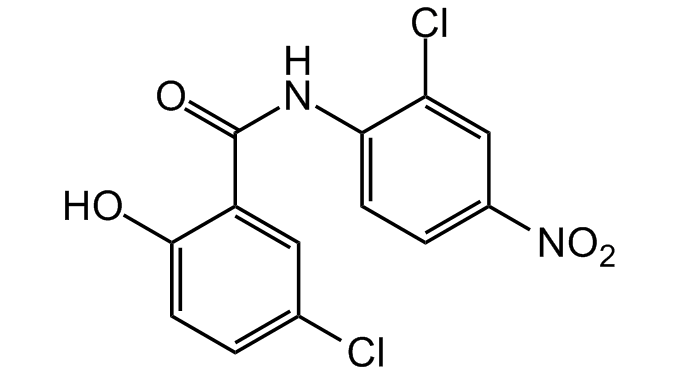Niclosamide
| Code | Size | Price |
|---|
| AG-CR1-3643-M100 | 100 mg | £40.00 |
Quantity:
| AG-CR1-3643-G001 | 1 g | £100.00 |
Quantity:
Prices exclude any Taxes / VAT
Overview
Regulatory Status: RUO
Shipping:
-20°C
Storage:
Short Term: 4°C Long Term: -20°C
Images
Documents
Further Information
Alternate Names/Synonyms:
5-Chloro-N-(2-chloro-4-nitrophenyl)-2-hydroxybenzamide; 2',5-Dichloro-4'-nitro-salicylanilide; BAY-2353; Bayluscid; Cestoid; HL2447; Yomesan
Appearance:
Off-white to pale yellow solid.
CAS:
50-65-7
EClass:
32160000
Form (Short):
liquid
GHS Symbol:
GHS07,GHS09
Handling Advice:
Keep cool and dry.Protect from moisture and oxygen.
Hazards:
H319, H400, H410
InChi:
InChI=1S/C13H8Cl2N2O4/c14-7-1-4-12(18)9(5-7)13(19)16-11-3-2-8(17(20)21)6-10(11)15/h1-6,18H,(H,16,19)
InChiKey:
RJMUSRYZPJIFPJ-UHFFFAOYSA-N
Long Description:
Chemical. CAS: 50-65-7. Formula: C13H8Cl2N2O4. MW: 327.1. Antihelminthic, molluscicide and trypanocidal agent that inhibits mitochondrial oxidative phosphorylation and anaerobic ATP production. Anticancer agent with antiproliferative activity in a broad spectrum of cancer cells. Targets and inhibits multiple signaling pathways, including STAT3, NF-kB, Wnt/beta-catenin, Notch and mTORC1. Shown to block TNF-alpha-induced IkappaBalpha phosphorylation, translocation of p65 and the expression of NF-kappaB-regulated genes and elevates reactive oxygen species (ROS) levels. Promotes Frizzled1 internalization, down-regulates the expression of Dishevelled-2 protein and inhibits beta-catenin stabilization. Inhibits mTORC1 but not mTORC2 signaling in cells maintained in nutrient-rich conditions. Cell permeable selective STAT3 inhibitor (IC50=0.25µM). Inhibits the activation, nuclear translocation and transactivation of STAT3. Selective over STAT1, STAT5, JAK1, JAK2 and Src kinases. Induces cell cycle arrest, growth inhibition, autophagy and apoptosis. Inhibits S100A4 (Metastasin-1)-induced metastasis in vivo. Inhibits androgen receptor (AR) splice variants. Anti-inflammatory compound. Quorum sensing inhibitor. Broad range antiviral agent that targets acidified endosomes. Antiobesity and antidiabetic agent. Positive allosteric neuropetide Y4 receptor ligand and increases energy expenditure and lipid metabolism through mitochondrial uncoupling.
MDL:
MFCD00057597
Molecular Formula:
C13H8Cl2N2O4
Molecular Weight:
327.1
Package Type:
Vial
Precautions:
P273, P280, P305, P351, P338, P337, P313
Product Description:
Antihelminthic, molluscicide and trypanocidal agent that inhibits mitochondrial oxidative phosphorylation and anaerobic ATP production. Anticancer agent with antiproliferative activity in a broad spectrum of cancer cells. Targets and inhibits multiple signaling pathways, including STAT3, NF-kB, Wnt/beta-catenin, Notch and mTORC1. Shown to block TNF-alpha-induced IkappaBalpha phosphorylation, translocation of p65 and the expression of NF-kappaB-regulated genes and elevates reactive oxygen species (ROS) levels. Promotes Frizzled1 internalization, down-regulates the expression of Dishevelled-2 protein and inhibits beta-catenin stabilization. Inhibits mTORC1 but not mTORC2 signaling in cells maintained in nutrient-rich conditions. Cell permeable selective STAT3 inhibitor (IC50=0.25µM). Inhibits the activation, nuclear translocation and transactivation of STAT3. Selective over STAT1, STAT5, JAK1, JAK2 and Src kinases. Induces cell cycle arrest, growth inhibition, autophagy and apoptosis. Inhibits S100A4 (Metastasin-1)-induced metastasis in vivo. Inhibits androgen receptor (AR) splice variants. Anti-inflammatory compound. Quorum sensing inhibitor. Broad-spectrum antiviral agent that targets acidified endosomes. Has been shown to inhibit replication of SARS and is a potential candidate to treat SARS-CoV-2 (COVID-19) infections. Antiobesity and antidiabetic agent. Positive allosteric neuropetide Y4 receptor ligand and increases energy expenditure and lipid metabolism through mitochondrial uncoupling.
Purity:
>95%
Signal word:
Warning
SMILES:
OC1=CC=C(Cl)C=C1C(NC2=CC=C([N+]([O-])=O)C=C2Cl)=O
Solubility Chemicals:
Soluble in 100% ethanol (5mg/ml) or DMSO (1mg/ml). Insoluble in water.
Transportation:
Non-hazardous
UNSPSC Category:
Biochemical Reagents
UNSPSC Number:
12352200
Use & Stability:
Stable for at least 2 years after receipt when stored at -20°C.
References
The effect of sublethal concentrations of the molluscicide niclosamide on the infectivity of Schistosoma mansoni cercariae: A.M. Ghandour & G. Webbe; J. Helminthol. 49, 245 (1975) | Inhibition of Severe Acute Respiratory Syndrome Coronavirus Replication by Niclosamide: C.J. Wu, et al.; Antimicrob. Agents Chemother. 48, 2693 (2004) | In vitro trypanocidal activity of the anti-helminthic drug niclosamide: K. Merschjohann & D. Steverding; Exp. Parasitol. 118, 637 (2008) | The anti-helminthic niclosamide inhibits Wnt/Frizzled1 signaling: M. Chen, et al.; Biochem. 48, 10267 (2009) | Screen for chemical modulators of autophagy reveals novel therapeutic inhibitors of mTORC1 signaling: A.D. Balgi, et al.; PLoS One 4, e7124 (2009) | Identification of niclosamide as a new small-molecule inhibitor of the STAT3 signaling pathway: X. Ren, et al.; ACS Med. Chem. Lett. 1, 454 (2010) | Antineoplastic mechanisms of niclosamide in acute myelogenous leukemia stem cells: inactivation of the NF-kappaB pathway and generation of reactive oxygen species: Y. Jin, et al.; Cancer Res. 70, 2516 (2010) | Niclosamide: an established antihelminthic drug as a potential therapy against S100A4-mediated metastatic colon tumors: D.M. Helfman; J. Natl. Cancer Inst. 103, 991 (2011) | Niclosamide induces mitochondria fragmentation and promotes both apoptotic and autophagic cell death: S.J. Park, et al.; BMB Rep. 44, 517 (2011) | Niclosamide suppresses cancer cell growth by inducing Wnt co-receptor LRP6 degradation and inhibiting the Wnt/beta-catenin pathway: W. Lu, et al.; PLoS One 6, e29290 (2011) | Niclosamide, an old antihelminthic agent, demonstrates antitumor activity by blocking multiple signaling pathways of cancer stem cells: J.X. Pan, et al.; Chin. J. Cancer 31, 178 (2012) (Review) | Niclosamide is a proton carrier and targets acidic endosomes with broad antiviral effects: A. Jurgeit, et al.; PLoS Pathog. 8, e1002976 (2012) | New life for an old drug: the anthelmintic drug niclosamide inhibits Pseudomonas aeruginosa quorum sensing: F. Imperi, et al.; Antimicrob. Agents Chemother. 57, 996 (2013) | The anthelmintic drug niclosamide induces apoptosis, impairs metastasis and reduces immunosuppressive cells in breast cancer model: T. Ye, et al.; PLoS One 9, e85887 (2014) | Multi-targeted therapy of cancer by niclosamide: A new application for an old drug: Y. Li, et al.; Cancer Lett. 349, 8 (2014) (Review) | Niclosamide inhibits androgen receptor variants expression and overcomes enzalutamide resistance in castration-resistant prostate cancer: C. Liu, et al.; Clin. Cancer Res. 20, 3198 (2014) | Niclosamide ethanolamine-induced mild mitochondrial uncoupling improves diabetic symptoms in mice: H. Tao, et al.; Nat. Med. 20, 1263 (2014) | Niclosamide inhibits the inflammatory and angiogenic activation of human umbilical vein endothelial cells: M. Huang, et al.; Inflamm. Res. 64, 1023 (2015) | Discovery of small-molecule modulators of the human Y4 receptor: G. Sliwoski, et al.; PLoS One 11, e0157146 (2016) | Broad Spectrum Antiviral Agent Niclosamide and Its Therapeutic Potential: J. Xu, et al.; ACS Infect. Dis. (Epub ahead of print) (2020) (Review)



